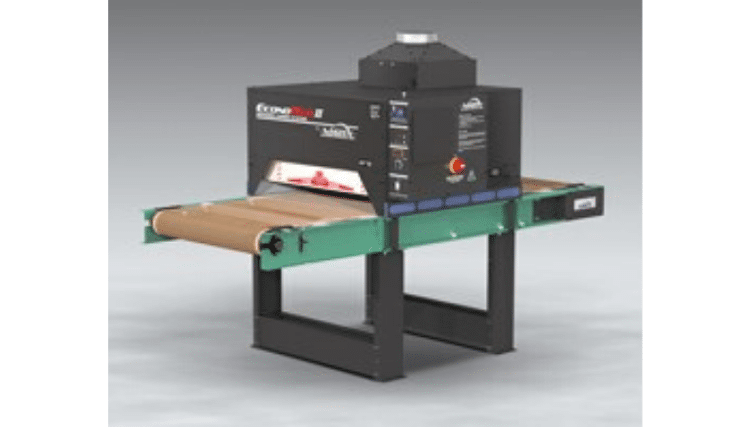New EconoRed II Dryer cures plastisol/water-based inks

A new EconoRed™ II-30 high capacity dryer from Vastex cures up to 300 plastisol-printed garments/h, and 100 garments/h screen printed with water-based ink or discharge, it was announced by Mark Vasilantone, president.
The dryer is 20 percent quieter and 13 cm narrower than its EC II-30 predecessor owing to its top-mounted exhaust system, and allows positioning of the control box on the right (standard) or left side of the enclosure to suit shop layouts.
It is equipped as standard with a 76 cm wide conveyor belt and two 61 cm wide, 3600 watt heaters (total 7,200 watts). Capacity can be doubled, tripled or quadrupled as needs grow by adding one, two or three additional heating chambers, extending the belt length and increasing the belt speed.
The heaters feature closely spaced coils that provide high-density, medium-wavelength infrared heat for maximum cure speed without cold spots or under-curing, and come with a 15-year warranty.A “Vastex Infrared Focusing System” allows heater adjustment to any height from 5 to 18 cm above the belt, allowing the operator to compensate for garment thickness.
To cool the outer cabinet while evacuating moisture and fumes, EconoRed II-30 single-chamber models are equipped with a 10 m3/min. exhaust system, while two-chamber models utilise a 21.5 m3/min. system.
All models include a digital PID temperature controller accurate to +/- 1°C, allowing the operator to accurately repeat or fine-tune drying results, and a belt tracking system for increased belt life.
Mr. Vasilantone says an EconoRed™ ER-II-54 version with 137 cm wide conveyor belt will soon follow.
The company also produce specialised DTG-capable multi-function dryers with capacities from 110+ to 950+ pieces per hour per chamber, as well as commercial-grade and entry-level manual screen printing presses, flash cure units, screen exposing units, screen drying cabinets, washout booths and complete screen printing shop systems.
Topics
Interested in joining our community?
Enquire today about joining your local FESPA Association or FESPA Direct
Recent news

The importance of ink for large format printers
Ink is crucial for large format inkjet printers, influencing substrate compatibility, productivity, and cost. Nessan Cleary discusses the three main types which include UV-curable ink, latex ink and eco-solvent ink. Each ink type has specific strengths and weaknesses, making printers choice dependent on budget and intended applications.

What are the benefits of Direct-To-Fabric printing?
Direct-to-fabric printing is gaining popularity for high-volume textile production, enabling on-demand, customized short runs. These printers offer ink flexibility, accommodating various fabric types like cotton and silk, though ink development focuses on faster turnaround by reducing pre- and post-processing. Compared to traditional methods, direct-to-fabric inkjet printing is a more sustainable option due to reduced water and chemical usage, and localized production.

What are the opportunities for large format providers regarding digital touch screens?
Digital touchscreens are becoming increasingly common, offering businesses opportunities to improve customer engagement and streamline operations. Nessan Cleary shares, while more expensive to implement than standard digital displays due to complex software and integration needs, touchscreens provide self-service options, multilingual support, and can reduce staffing costs in various settings like retail, transportation, and healthcare.
